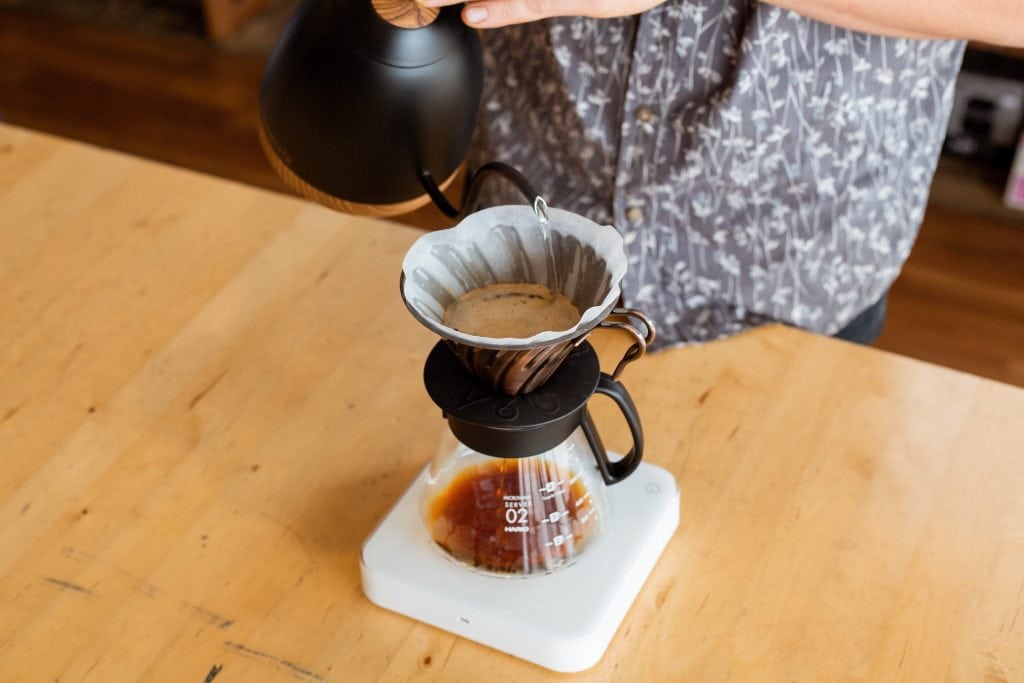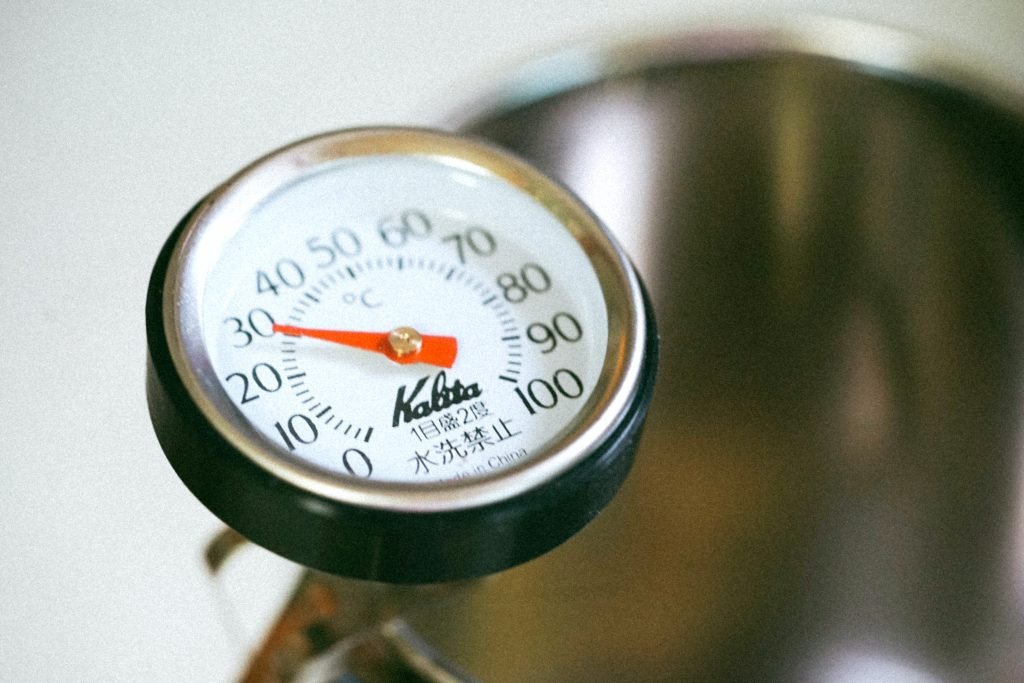After some time learning and practicing Tetsu Kasuya’s 4:6 coffee brewing method for V60 I had many questions.
If you’re looking to emulate Kasuya’s method or you’re just curious about it, I wrote this article for you.
Principles
“I give this method as a rough guide about how much you should pour and when, but I think you’ll have more fun by experimenting by yourself and finding your own way”
Tetsu Kasuya
According to Kasuya, you can control coffee taste by dividing the pour-over into two separate stages:
The first 40% of pour-over determines sweetness and acidity and the remaining 60% decides the brew strength.
I don’t know about any scientific or double-blind experiments available to support these principles. However, many pour-over coffee enthusiasts and experts assert the 4:6 method works as expected.
A quick note about coffee extraction in 4:6 method ☕
In short, coffee extraction is making a water-based solution with coffee grounds. The SCA Brewing Foundations identify several key variables for coffee recipes.
The most crucial variables for coffee brewing are:
- Brew Ratio: proportion between coffee and water. It determines how concentrated will be the cup of coffee
- Grind size: the finer the grind size, the higher that extraction is going to be
- Contact time: the longer the coffee grounds are in contact with water, the more they dissolve in water
- Water temperature: higher temperatures extract more flavors and aromas from coffee grounds, quicker
- Turbulence: accelerates extraction moving the brew
Tetsu Kasuya 4:6 Coffee Brewing Method For V60 uses turbulence to deal with extraction, as the best from any coffee comes out first. Including sweetness and acidity.
The 45 seconds between each pour let coffee cool down, so each pour will create temperature peaks for a few seconds, extracting more coffee shortly after each pour when the turbulence occurs.
A coarse grind size, as Kasuya recommends, offers a lighter, cleaner, and crisp cup of coffee. It’s the kind of infusion that could make us remember a perfect cup of tea, without astringency or bitterness.
Most conventional coffee lovers would say this kind of brew is dull, as many expect some bitterness and oils in their cup.
Personally, I prefer a finer grind to create a bolder cup of coffee. As Kasuya said, it’s better if you experiment and find your preferred brew.
Now, let’s get back to it!
Instructions

- Put the paper filter on the V60
- Wet the filter to remove the paper taste. World Brewers Cup 2014 Champion Stefanos Domatiotis claims that it’s better to weigh how much water you use to wet the paper filter. I use about 30 grams of water to do that. As long as you remain consistent and learn the role it plays to clean the paper taste from your filters, it should be OK
- Transfer the water to another recipient for another use. I let it cool so I can use it to water my garden or my compost.
- Add 20 gr of coffee grounds. Kasuya recommends using coarse grounds but I prefer medium. Like with anything, you’ll need to experiment to find a brew that suits your preference. Grind size is crucial.
- Pour over water over the coffee grounds. This will be the first pour, consisting of three times as much water as the grounds.
- Leave around 45 seconds between each pour
- The first two pours determine acidity and sweetness, according to Tetsu Katsuya. To increase sweetness, Kasuya recommends changing the pours’ distribution. Using less water for the first pour and adding the difference to the second pour would increase sweetness. For instance, instead of pouring 60 ml in the first pour, adding 50 ml in the first pour and then 70 ml for the second pour
- To increase acidity, doing the opposite should work. Add more water in the first pour and less water in the second pour. Making these adjustments you should pour the coffee grounds with 120 ml of water, summing the two first pours.
- The last three pours determine brew strength. To reduce strength Kasuya suggests reducing the number of pours. For instance, using two 90 ml pours for the last 180 ml, instead of three 60 ml pour.
- Serve and enjoy. The whole process takes around 3:30 minutes, according to Tetsu Kasuya
Matching Temperatures and Roast Types ????

To improve extraction, Tetsu Kasuya recommends playing with water temperature and roast types. According to Kasuya, dark roasts taste better with lower temperatures.
Find the recommended matches below, but keep in mind that Kasuya’s suggestions aren’t rules, but guidelines.
| Roast ???? | Recommended Temperature ????️ |
|---|---|
| Dark | 80 °C |
| Medium | 87-90 °C |
| Light | 95 °C |
What do experts and enthusiasts think about it?

Tetsu Kasuya’s 4:6 coffee brewing method for V60 has quite a few adepts among pour-over coffee enthusiasts.
Gustavo Paparoni, Authorized SCA Trainer, told me that Kasuya’s method is among his favorites. Actually, he recommends the 4:6 method and pays special attention to matching roast types and water temperatures. Paparoni agrees with Kasuya about the role of the sequence and pours’ volume in the resulting cup.
Mark Paradis, from Curious About Coffee, is a fellow coffee enthusiast and he shared an interesting insight about his experience using the 4:6 method. Coffee altitude can play a role in taste as well, so Mark grinds finer the coffee beans from higher locations.
Jonathan Gagné is a scientist with a serious enthusiasm for coffee. Gagné’s blog, Coffee Ad Astra, is for coffee nerds looking for scientific rigor and I recommend it if you’re craving for that type of content.
Gagné promotes using the scientific method to improve coffee, so the lack of experimental procedures, data, and double-blind tests supporting Tesuya’s method is a major issue from his standpoint.
Ada Chou, another fellow coffee enthusiast highlights several points that are quite important to understand and experiment with Kasuya’s method. Bean origin, varietal, and roast profile are crucial to determining the intended coffee brew flavor profile.
On the other hand, as Ada explains, Tetsu Kasuya’s 4:6 coffee brewing method for V60 focuses on extracting different flavors out of coffee grounds in different stages of brewing.
On balance, it’s hard to know how much of the 4:6 method results are repeatable. In my experience, coffee taste and strength do change adjusting pours as suggested by Kasuya. However, I am not sure if these pour adjustments can play a more significant role than grind size. Assuming that we’re using top-quality coffee grounds, of course.
In conclusion, Tetsu Kasuya’s 4:6 coffee brewing method for V60 offers a simple and structured way of playing with coffee extraction. Still, it isn’t grounded in scientific evidence and opinions vary widely about the method’s benefits.
Kasuya created the method in 2016, so it’s hardly just another fad and since its creation, the 4:6 method has inspired hundreds of coffee enthusiasts.
If you’re curious about coffee brewing, check out my article on how you can elevate your coffee experience with a few easy hacks to find more info!


